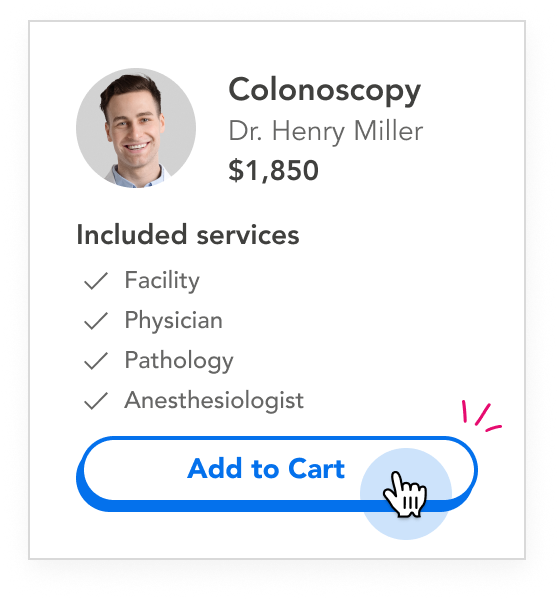
Gastric Sleeve (inpatient)
(11) Reviews from people who purchased this procedureESTIMATED
NATIONAL AVERAGE
MDSAVE
NATIONAL AVERAGE
How Much Does a Gastric Sleeve (inpatient) Cost?
Purchase a Gastric Sleeve (inpatient) today on MDsave. Costs range from $8,899 to $26,877. Those on high deductible health plans or without insurance can save when they buy their procedure upfront through MDsave. Read more about how MDsave works.Find Gastric Sleeve (inpatient) providers near you
Search board-certified providers, compare prices, buy online, and save money.
What Our Customers Say
Browse 87 Providers in these Locations
Choose your location to find Gastric Sleeve (inpatient) providers near you.
Shop with
Peace of Mind
Financing options
Promotional financing available when you pay with CareCredit. What is CareCredit?
MONEY BACK GUARANTEE
We will refund your payment in full if you end up not needing your purchased procedure and do not receive care. Details

Procedure Details
What is a Gastric Sleeve?
A gastric sleeve, also known as a sleeve gastrectomy, is a type of bariatric surgery that helps encourage reduced calorie intake by decreasing the stomach’s capacity to hold food. In this surgery, about 75% of the stomach is removed and the open edge is closed with staples, leaving only a narrow, banana-shaped tube, or “sleeve.”
The reduced stomach feels full faster and facilitates the long-term loss of excess body weight by restricting the amount of calories that can be consumed, but it can also help achieve greater feelings of satiety and a decrease in appetite. Removing the larger portion of the stomach can reduce the body’s production of a hormone called ghrelin, which affects the sensation of hunger. Many patients report feeling less hungry after having the gastric sleeve surgery.
What Can You Expect During a Gastric Sleeve?
Gastric sleeve is commonly performed laparoscopically, which is a minimally invasive surgical technique that only requires small incisions and typically has a much quicker recovery period than traditional open surgeries. Sleeve surgery often has a short inpatient recovery time of about two days.
Unlike some other bariatric surgeries, the gastric sleeve is not reversible, because the stomach pouch is removed. However, it also does not require any implanted devices like gastric banding, or changes to the digestive pathway like gastric bypass surgery. With mindful adherence to proper diet and exercise, most patients lose 50% of their excess weight or more within the first three years.
Are You a Good Candidate for Gastric Sleeve Surgery?
Weight loss surgery like gastric sleeve may be recommended for patients who have a BMI of 40 or higher. In some cases, patients with a BMI of 35 or higher may qualify if they also suffer from obesity-related health problems like diabetes, sleep apnea, joint pain, heart disease and hypertension.¹ ² In addition, most patients must have tried and failed to lose weight through traditional diet and exercise before bariatric surgery will be considered. Check with your insurance company to see if they cover any bariatric surgery, and if so, what requirements must be met.
Before undergoing weight loss surgery, most patients will have to go through a screening process. Patients must be willing to follow a nutrition and exercise plan to both achieve and maintain a healthy weight and commit to follow-up visits and possibly vitamin or mineral supplementation.³ A patient must also be healthy enough for surgery, both physically and mentally. A psychological evaluation is typically included in pre-operative screenings. Doctors must determine if the benefits of bariatric surgery outweigh the risks before the procedure will be performed.
What is the Difference Between Gastric Sleeve and Gastric Bypass?
The biggest difference between a gastric sleeve and gastric bypass surgery is that gastric sleeve does not alter the path that food takes through the body, whereas gastric bypass reroutes food from the top of the stomach to a lower section of the small intestines, bypassing the lower stomach and upper portion of the small intestines entirely.
The most common type of gastric bypass surgery, known as Roux-en-Y gastric bypass, facilitates weight loss in two ways: it reduces the size of the stomach, restricting the amount of food that can be consumed, and it also changes the way the small intestines absorb food.
Bypass surgery has two parts. First, the top part of the stomach is separated from the rest and formed into a small pouch that can hold about one ounce. The rest of the stomach is not removed from the body. Second, the small intestine is divided, and the lower opening is attached to the newly formed stomach pouch. This bypasses most of the stomach and the top of the small intestine, which may reduce the number of calories and nutrients absorbed. The open end of the bypassed top portion of the small intestine is finally attached to the lower portion of the intestine so that stomach acids and digestive enzymes can come in contact with the food as it passes away from the stomach pouch.
Gastric sleeve typically has a quicker in-hospital recovery time than gastric bypass, about two days as opposed to three to five. Because gastric sleeve is a less technically complicated surgery, it has a lower incidence of surgical complications. In addition, gastric bypass fundamentally alters the way the body absorbs nutrients and calories, and so bypass patients are more likely than gastric sleeve patients to develop vitamin or mineral deficiencies.
What are the Benefits and Risks of Gastric Sleeve Surgery?
Gastric sleeve surgery reduces the size of the stomach by about 75-80 percent, which decreases the stomach’s capacity to hold food and encourages lower calorie intake. In addition, removing the larger part of the stomach can decrease appetite and increase feelings of satiety by decreasing ghrelin, the hormone responsible for hunger. Gastric sleeve, unlike other bariatric surgeries, does not introduce implantable devices into the body or reroute the digestive pathway. Many patients experience a decrease of greater than 50 percent of excess body weight within the first three to five years, and more than 50 percent are able to keep it off.4
Gastric sleeve, like all bariatric procedures, may alter how the body absorbs nutrients, so patients may need to follow a supplement plan to prevent vitamin and mineral deficiencies. In a very small number of patients, an average of 2.4 percent,5 leaks may occur along the staple line, where the sleeve is closed after the rest of the stomach is removed. If staple line leaks occur, surgical intervention to close the leak may be required.6
Any weight loss surgery that alters the stomach, like gastric sleeve or gastric bypass, has the chance to cause a condition called dumping syndrome. In dumping syndrome, food (particularly sugars) moves from the stomach into the small intestine too quickly, where it can cause symptoms like nausea, vomiting, cramps, diarrhea, and dizziness, among others. Eating small meals and avoiding sugary foods can often help prevent dumping syndrome.
What Other Conditions Can Be Improved by Gastric Sleeve Surgery?
Gastric sleeve procedures can improve quality of life for many patients struggling with obesity, including making it easier to perform everyday activities. In addition, bariatric surgery can help alleviate symptoms of other obesity-related conditions:
- Gastroesophageal reflux disease (GERD)
- Obesity-related heart disease
- High blood pressure (hypertension)
- Sleep apnea
- Type 2 diabetes
- Weight-related stroke
1 https://www.marinahospital.com/blog/who-is-a-good-candidate-for-gastric-sleeve-surgery
2 https://asmbs.org/patients/who-is-a-candidate-for-bariatric-surgery
3 https://www.mayoclinic.org/about/pac-20394258
4 https://asmbs.org/patients/bariatric-surgery-procedures
5 https://www.bariatric-surgery-source.com/risk-of-leaks-after-gastric-sleeve.html
6 https://www.ncbi.nlm.nih.gov/pmc/articles/PMC4194572/
Patient Reviews
4.8
What did you like most about using MDsave?
Knowing upfront, but my procedure cost and being able to lock at a price
What could we do to improve?
Improvement needed. I received customer service
What did you like most about using MDsave?
Easy, straight forward, and fast
What could we do to improve?
Nothing. It was easy and quick.
What did you like most about using MDsave?
Ease of purchase
What could we do to improve?
Provide more information regarding BlisCare and how to use it if needed
What did you like most about using MDsave?
The cost, my insurance died covered the surgery I had. So my expense was totally out of pocket. Bev of MDsave I was able to get my surgery.
What could we do to improve?
Maybe a little more advertisement though social media.
What did you like most about using MDsave?
price
What could we do to improve?
I had a good experience.
Get Care In Three Easy Steps
Compare Upfront Prices

Search by procedure and location to browse local providers and compare upfront pricing.
Buy Your Procedure

Pay for your procedure online or by calling (844) 256-7696. Or buy your procedure at the facility before your appointment is scheduled.
Receive Your Care

Follow the scheduling instructions given by your provider. Bring your voucher to your appointment.
Procedures
© Copyright 2025 MDsave Incorporated.
All Rights Reserved.